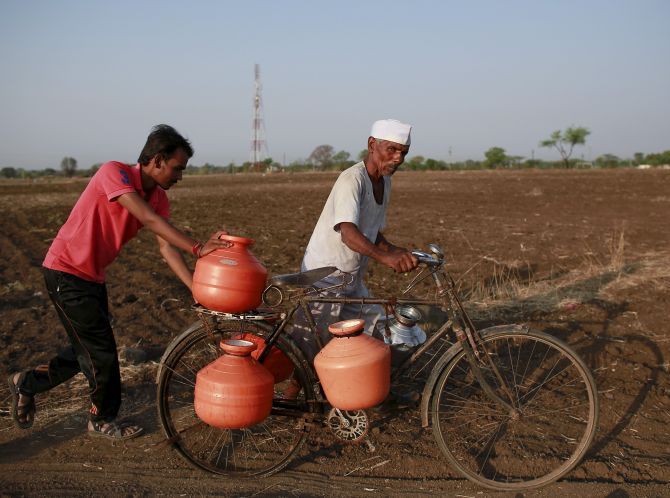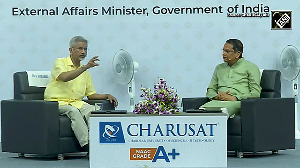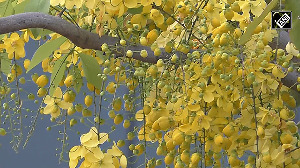'Drought in the 1990s was essentially the drought of a poor India.'
'This 2016 drought is of a richer and more water-guzzling India.'
'The severity and intensity of the drought is not about lack of rainfall.'
'It is about the lack of planning and foresight, and criminal neglect.'
On Wednesday, May 11, the Supreme Court pulled up the Centre and states for its tardy response to the drought ravaging India.
Rashme Sehgal reports for Rediff.com on the huge crisis which affects 330 million people in 10 states.
And please do read the related heart-rending reports at the bottom of Rashme's special report.

A dance of death is taking place in the drought-affected villages of Marathwada.
Kevalbai Kamble, 45, was standing in a queue for over two hours in the drought-affected Latur district to fetch water from a borewell. The intense heat took its toll. She collapsed, was rushed to the local government hospital where she was declared dead on arrival.
In Beed, Sachin Kengar, 9, slipped and drowned while trying to draw water from a well whose water levels had fallen by 30 feet or so. The villagers tried to revive him, but failed.
A few days earlier, Yogita Desai, 12, died of dehydration while making her fourth trip in the day to draw water from a borewell. The day on which she died, the temperature in Beed, one of the seven drought-affected districts in Marathwada for the third year in a row, was over 42 degrees Celsius.
Over 330 million people across ten states of India suffer severe water shortage due to the failure of the monsoons. Telangana and Bundelkhand region in Uttar Pradesh are amongst the worst affected and children have being entrusted with the task of making multiple trips to borewells and wells to draw water in blazing temperatures.
Already, government estimates that more than 200 people have died due to heatstroke.
Met department officials say they have not recorded such high temperatures for April in the last 100 years.
Farmers remain the worst affected in these drought-affected regions and suicides are rising alarmingly in these areas. On an average, National Crime Recording Bureau statistics highlight that there are over 10 farmers' suicides every day in Maharashtra for ten years in a row.
Suicides have gone up 42 per cent. On an average 3,685 farmers in Maharashtra have taken their lives every year from 2004 to 2013.
If this situation was not alarming enough, water availability in India's 91 reservoirs has reached its lowest levels in a decade, with stocks in Maharashtra presently dipping to 2 per cent of their total storage capacity according to the Central Water Commission. Levels in aquifers have also reached an all time low.
The government now depends on the monsoon to help end this drought without bothering to analyse that its policies have brought the country to this pass.
"Indian inequality is reflected in the way the government distributes water with India having the largest number of people without access to water," points out P Sainath, author of the acclaimed Everybody Loves A Drought.
" "There is a massive rural to urban diversion of water taking place," explains Sainath who has extensively reported on farmers' suicides. "While water is rural (in its generation), its consumption is urban. And even in the cities, slum dwellers receive between 40 to 70 litres per person per day while those living in (the posh) Malabar Hill in Mumbai get up to 500 litres per person per day."
"Water allocation is extremely lopsided," he adds. "Maharashtra has 38 districts. While Mumbai, Pune and Thane receive 53 per cent of water allocated in the state, 17 districts receive only one per cent of the drinking water. Beed gets one percent of the drinking water though it is the most drought affected."
The problem of drought is directly linked to irrigation because while the government has allocated Rs 1.8 lakh crore (Rs 18 trillion) for irrigation purposes, no financial allocation has been made for rural communities that do dry farming.
"A large swathe of farmers do not receive irrigated water. Why are we not promoting the growth of millets and pulses which are in such a short supply?" asks Sainath.
"In order to grow dal and pulses, the farmers need an assured income and for that we need a price policy. It is this lack of policy which has seen farmers move to high yielding crops and hybrid varieties in water deficit areas thereby lowering the ground water table even further," explains Sainath.
"The Economic Survey for this year highlighted that the average income of farmers was Rs 20,000 per annum. The average income per hectare for a farmer is as little as Rs 3,000. The government has deliberately kept agriculture impoverished, forcing farmers to leave their land. This is being deliberately pursued," he adds.
Speaking at the National Consultation on Drought in the capital, Sunita Narain, head of the Centre for Science and Environment, says, "Drought in the 1990s was essentially the drought of a poor India. This 2016 drought is of a richer and more water-guzzling India.
"This classless drought makes for a crisis that is more severe and calls for solutions that are more complex," says Narain. "The severity and intensity of the drought is not about lack of rainfall; it is about the lack of planning and foresight, and criminal neglect. The drought is human-made."
"Drought and food security are critically linked," says Richard Mahapatra, editor, Down to Earth. "Drought-prone districts account for 42 per cent of the country's cultivable land. For maintaining food security, even at the current nutritional levels, an additional 100 million tonnes of food grains need to be produced by 2020. According to estimates, 40 per cent of this additional supply has to come from these districts."
Supreme Court advocate Prashant Bhushan has stressed that the government must invoke the drought code in all these drought-affected areas so that farmers can be provided with proper relief as has been established by the drought manual.
Yogendra Yadav, national convenor, Swaraj Abhiyan, expresses the fear that the drought is turning into a famine especially in Bundelkhand, Marathwada and Telangana where villagers face an acute food scarcity.
Yadav evoked the real picture of drought through a letter from a Marathwada farmer which formed the basis of the PIL filed in the Supreme Court.
"There is a possibility that the drought will get worse in the future," says Yadav. "This is a policy induced disaster."
Environmental activist Darryl D'Monte believes the water crisis in Maharashtra has got worse because farmers, instead of growing millet, sorghum and other cereals have moved to growing water-guzzling sugarcane. D'Monte believes Maharashtra's powerful sugarcane lobby has deliberately ignored local climatic conditions in pursuit of profits.
Failed harvests have forced farmers to mortgage their land in order to buy seeds and fertilisers. Their failure to return these high interest loans have driven them to suicide.
Unfortunately, politicians do not seem to have any understanding of the problems being faced by the majority of Indians because they continue to indulge in tokenism rather than take effective steps towards mitigation.
Sunita Narain has suggested a three-pronged action plan to combat drought. The steps she has recommended include the need to build more water harvesting structures as part of the National Rural Employment Guarantee Act programme. All non-essential use of water including the watering of lawns to hosing down cars needed to be stopped and strong targets needed to be set to ensure reduced water consumption year on year.
Farmers possess traditional wisdom and if they had been allowed to follow their indigenous water management practices, this drought could have been avoided.
Instead, decades of groundwater abuse and populist water policies combined with climate change and an erratic monsoon have turned practically the whole country from Haryana to Bihar and from Maharashtra to Karnataka into a vast dust bowl.











 © 2025
© 2025